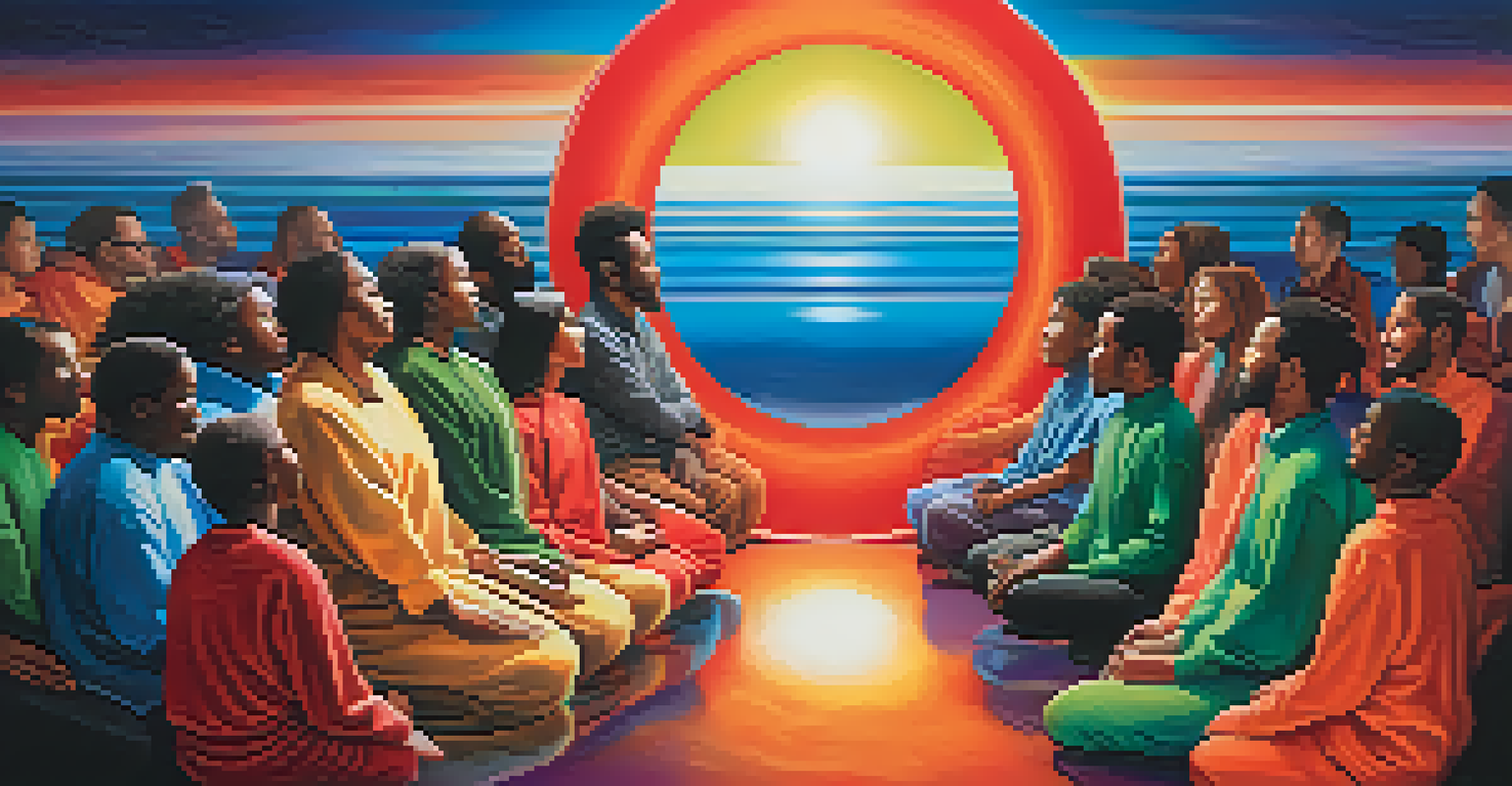Soundtrack to the Soul: Entheogens and Music Therapy

Understanding Entheogens and Their Role in Therapy
Entheogens, often derived from plants, are substances that can induce altered states of consciousness. These experiences can lead to profound insights and emotional healing, making them valuable in therapeutic settings. When paired with music, the effects of entheogens can be amplified, creating a multisensory experience that promotes deeper introspection.
Music can change the world because it can change people.
In therapy, entheogens like psilocybin or ayahuasca are used to facilitate breakthroughs in mental health. They help individuals confront traumas or deep-seated emotions in a safe environment. When combined with carefully curated music, these sessions can evoke powerful emotional responses, enhancing the therapeutic journey.
Understanding the synergy between music and entheogens is crucial for harnessing their full potential. Music acts as a guide, shaping the emotional landscape of the experience. This connection opens the door to healing and transformation, allowing individuals to navigate their inner worlds with greater ease.
The Science Behind Music and Emotional Healing
Research has shown that music can significantly influence our emotional states. It triggers the release of neurotransmitters like dopamine, which is often associated with feelings of pleasure and reward. This biological response can enhance the effects of entheogens, making sessions more impactful and meaningful.

When individuals listen to music during a therapeutic session, it can evoke memories or feelings that may be locked away. This process can facilitate catharsis, allowing for the release of pent-up emotions. It’s like opening a floodgate, where the right melodies can lead to moments of clarity and understanding.
Entheogens Enhance Emotional Healing
Entheogens, when paired with music in therapy, can facilitate deep emotional breakthroughs and insights.
Moreover, music provides a structure to the therapeutic experience. Just as a soundtrack sets the tone for a movie, music can guide individuals through the ups and downs of their emotional journey. This structured flow can help clients feel more at ease, encouraging them to dive deeper into their experiences.
Different Types of Music for Therapy Sessions
Not all music is created equal when it comes to therapy. Different genres, tempos, and rhythms can evoke varying emotional responses. For instance, ambient music may promote relaxation, while more rhythmic beats can encourage movement and expression, which are crucial in certain therapeutic contexts.
The mind is like a parachute. It doesn't work if it is not open.
Incorporating a mix of classical, world, and contemporary music can cater to diverse emotional landscapes. Classical music might help individuals feel grounded, while world music can introduce an element of adventure and exploration during the session. This eclectic approach ensures that the music resonates with the individual's unique journey.
Additionally, live music can enhance the experience even further. Musicians can adapt their performance to the emotional needs of the participants, creating a dynamic and responsive environment. This interaction can foster a sense of connection and presence, making the therapeutic space feel more alive and supportive.
Entheogens and Music: A Historical Perspective
The relationship between music and entheogens is not a modern phenomenon; it has deep historical roots. Indigenous cultures have long recognized the healing properties of both, often using music during sacred rituals that involve entheogenic substances. These practices highlight the enduring connection between sound and spiritual exploration.
For example, in many shamanic traditions, music is used to guide participants through their journeys while using entheogens. Drumming, chanting, and singing are integral to these rituals, serving both as a rhythm to follow and a means of communicating with the spirit world. This historical context adds depth to our understanding of how music can enhance the therapeutic use of entheogens.
Music Shapes Therapeutic Experiences
Music serves as a guiding force in therapy, influencing emotional landscapes and enhancing the overall healing journey.
By looking back at these traditions, we can glean valuable insights into creating modern therapeutic practices. Integrating ancient wisdom with contemporary methods can enrich the healing experience, providing a holistic approach that honors both the mind and spirit.
The Therapeutic Potential of Guided Music Journeys
Guided music journeys are a powerful therapeutic tool that combines music and entheogens in a structured way. In these sessions, a trained facilitator leads participants through a carefully designed experience, integrating music to support emotional exploration. This guidance helps individuals feel safe and supported throughout their journey.
During these journeys, the facilitator curates a playlist that aligns with the intended therapeutic goals. The music evolves throughout the session, mirroring the emotional landscape of the participants. This dynamic interplay creates a rich tapestry of sound, enhancing the depth of the experience and aiding in emotional processing.
Participants often report feelings of connection and unity during these guided journeys, not only with themselves but also with others in the room. This shared experience can foster a sense of community and support, making the therapeutic process feel less isolating. In this way, music becomes a bridge, connecting individuals to their inner selves and to one another.
Challenges and Considerations in Music Therapy
While the integration of music and entheogens in therapy holds immense potential, it is not without challenges. One significant consideration is the need for trained professionals who understand both the pharmacological effects of entheogens and the nuances of music therapy. This expertise is crucial to ensure a safe and effective therapeutic environment.
Additionally, individual responses to music and entheogens can vary widely. What resonates deeply with one person may not have the same effect on another. This variability underscores the importance of tailoring experiences to meet the unique needs of each participant, a task that requires careful planning and sensitivity.
Historical Roots of Music Therapy
The long-standing connection between music and entheogens in indigenous cultures highlights their combined therapeutic potential.
Moreover, there are ethical considerations surrounding the use of entheogens in therapy. These substances can evoke powerful emotions, and facilitators must approach these experiences with care and respect. Establishing a trusting relationship between the therapist and the participant is essential for navigating the complexities that may arise during sessions.
The Future of Music Therapy with Entheogens
As interest in alternative therapies grows, the future of music therapy combined with entheogens looks promising. Research is expanding, and clinical studies are beginning to explore the therapeutic benefits of this unique pairing. This evolution may lead to broader acceptance and integration of these practices within conventional mental health frameworks.
Moreover, as more individuals share their positive experiences, the stigma surrounding entheogens is slowly dissipating. This shift paves the way for further exploration into their potential in therapy, particularly when paired with the powerful medium of music. Both fields are ripe for innovation, and creative approaches are likely to emerge.

Ultimately, the convergence of music and entheogens in therapeutic contexts holds the promise of profound healing. By continuing to explore this intersection, we can uncover new pathways to emotional well-being, offering individuals the opportunity to connect with their true selves in transformative ways.